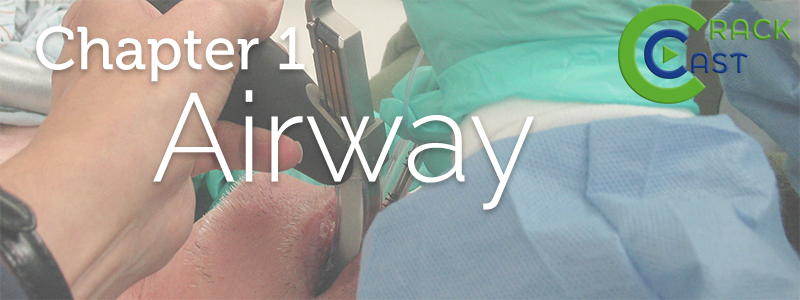As highlighted in Rosen’s, the airway really is “the cornerstone of resuscitation and is a defining skill for the specialty of emergency medicine.” One important piece of this skill set is knowing when we need to take the airway.
Shownotes – PDF Here
[bg_faq_start]1. How do you make the decision to intubate?
- Failure to maintain or protect the airway
- Can’t handle gastric and oral secretions
- Failure to ventilate or oxygenate
- ABG rarely useful
- Patient’s anticipated clinical course and likelihood of deterioration
- Multiple trauma, open#, neck trauma, burns[bg_faq_end]
[bg_faq_start]
2. What are predictors of difficult bag valve mask ventilation?
MOANS
- Mask seal
- Obstruction or obesity
- Age > 55
- No teeth
- Stiffness of chest
- Asthma, COPD, pregnancy
This is a fundamental skill we must learn so continue to practice this whenever you can.[bg_faq_end] [bg_faq_start]
3. What are the predictors of difficult intubation?
LEMON
- Look for gestalt signs :
- ***KEY sign is the presence of an underbite: if the patient CANNOT bite their upper lip with their lower teeth (buck teeth boy) they will be a very difficult tube!!***
- Evaluate the 3-3-2 rule
- Mouth opening, length of mandible, and thyromental distance
- A high riding larynx and receding mandible = impossible tube
- Mallampati score :
- Mallampati I = easy; Mallampati IV = challenging
- Use a Laryngoscope to visualize in obtunded pts.
- Obstruction or obesity
- Epiglottitis, ludwig’s angina, etc.
- Neck mobility
- Spondylosis, Rheumatoid Arthritis, etc.
Bonus: Cormack Lehane grading view
- Classifies views obtained on direct laryngoscopy
- Scale from 1-4 (see Rosen’s)
- 4 = not even the epiglottis seen.
- 2a = arytenoids and portion of vocal chords, 2b=arytenoids only
- POGO system can also be used[bg_faq_end]
4. What are the predictors of difficult LMA insertion?
RODS
- Restricted mouth opening
- Obstruction/obesity
- Distorted anatomy
- Stiffness to ventilate[bg_faq_end]
5. What are the predictors of a difficult surgical airway?
SMART
- Surgery (previous to area)
- Mass (abscess, hematoma)
- Access/anatomy problems (obesity, edema)
- Radiation (previous to area)
- Tumor[bg_faq_end]
6. Differentiate depolarizing vs. non-depolarizing paralytic agents?
Depolarizing Agents
Work by mimicking the Ach molecule
- Succinylcholine : Depolarizes the motor end plate
- 45 sec to effect.
- Respiration recover at 6-10 mins
- Many contraindications
Non-Depolarizing Agents
Nondepolarizing, competitive antagonism (prevents access of Ach on the receptors)
- Onset 60 secs
- Lasts 50 mins
- NO contraindications[bg_faq_end]
7. What are the contraindications to succinylcholine?
NEVER
- Neuromuscular diseases
- ALS, Myotonic muscular dystrophy, MS, etc.
INJURED (> 5 days) (see table 1-2, chapter 1)
- Burn (>10%)
- Crush
- Denervation (spinal cord injury, stroke)
- Intra-abdominal sepsis[bg_faq_end]
Bonus: Crash Airway vs. Failed Airway
Crash Airway
- Agonal breathing, near death, circulatory collapse, not protecting airway, not mentating
- Need intubation, do not need paralysis as LOC so low (airway reflexes not intact)
- No drugs needed, except possible single large dose of succinylcholine (2mg/kg) if unable to tube
Failed Airway (can’t ventilate, can’t oxygenate)
- Failure to intubate despite three attempts at RSI by experienced operator
- Failure to oxygenate using BVM or EGD
- Experienced clinician identifies a grade 4 view on their first attempt[bg_faq_end]



